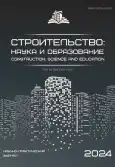Selection of thermal accumulative material to develop “smart ink” for 3D printing in the construction industry
- Авторлар: Sokolnikova S.R.1, Inozemtsev A.S.1
-
Мекемелер:
- Moscow State University of Civil Engineering (National Research University) (MGSU)
- Шығарылым: Том 14, № 1 (2024)
- Беттер: 123-134
- Бөлім: Building materials and products. Technologies for building materials production. Nanomaterials and nanotechnologies
- URL: https://journal-vniispk.ru/2305-5502/article/view/255937
- DOI: https://doi.org/10.22227/2305-5502.2024.1.8
- ID: 255937
Дәйексөз келтіру
Толық мәтін
Аннотация
Авторлар туралы
S. Sokolnikova
Moscow State University of Civil Engineering (National Research University) (MGSU)
Email: srsokolnikova@mail.ru
ORCID iD: 0000-0002-0896-4512
SPIN-код: 8761-0875
A. Inozemtsev
Moscow State University of Civil Engineering (National Research University) (MGSU)
Email: InozemcevAS@mgsu.ru
ORCID iD: 0000-0001-7807-688X
SPIN-код: 2444-1204
Әдебиет тізімі
- Mohan M.K., Rahul A.V., Schutter G.D., Tittelboom K.V. Extrusion-based concrete 3D printing from a material perspective : a state-of-the-art review // Cement and Concrete Composites. 2021. Vol. 115. P. 103855. doi: 10.1016/j.cemconcomp.2020.103855
- Иноземцев А.С. Современная теория и практика технологии бетонов для 3D-печати в строи-тельстве // Вестник МГСУ. 2024. Т. 19. № 2. С. 216–245. doi: 10.22227/1997-0935.2024.2.216-245
- Raphael B., Senthilnathan S., Patel A., Bhat S. A review of concrete 3D printed structural members // Frontiers in Built Environment. 2023. Vol. 8. doi: 10.3389/fbuil.2022.1034020
- Пустовгар А.П., Адамцевич Л.А., Адам-цевич А.О. Международный опыт исследований в области аддитивного строительного производ-ства // Жилищное строительство. 2023. № 11. С. 4–10. doi: 10.31659/0044-4472-2023-11-4-10. EDN FOCIIT.
- Jahangir M.H., Ziyaei M., Kargarzadeh A. Evaluation of thermal behavior and life cycle cost analysis of greenhouses with bio-phase change materials in multiple locations // Journal of Energy Storage. 2022. Vol. 54. P. 105176. doi: 10.1016/j.est.2022.105176
- Jayalath A., San Nicolas R., Sofi M., Shanks R., Ngo T., Aye L. et al. Properties of cementitious mortar and concrete containing micro-encapsulated phase change materials // Construction and Building Materials. 2016. Vol. 120. Pp. 408–417. doi: 10.1016/j.conbuildmat.201b6.05.116
- Hunger M., Entrop A.G., Mandilaras I., Brouwers H., Founti M. The behavior of self-compacting concrete containing micro-encapsulated phase change materials // Cement and Concrete Composites. 2009. Vol. 31. Issue 10. Pp. 731–743. doi: 10.1016/j.cemconcomp.2009.08.002
- Eddhahak A., Drissi S., Colin J., Caré S., Neji J. Effect of phase change materials on the hydration reaction and kinetic of PCM-mortars // Journal of Thermal Analysis and Calorimetry. 2014. Vol. 117. Issue 2. Pp. 537–545. doi: 10.1007/s10973-014-3844-x
- Aguayo M., Das S., Maroli A., Kabay N., Mertens J.C. E., Rajan S.D. et al. The influence of microencapsulated phase change material (PCM) characteristics on the microstructure and strength of cementitious composites: Experiments and finite element simulations // Cement and Concrete Composites. 2016. Vol. 73. Pp. 29–41. doi: 10.1016/j.cemconcomp.2016.06.018
- Jeong S.-G., Jeon J., Cha J., Kim J., Kim S. Preparation and evaluation of thermal enhanced silica fume by incorporating organic PCM, for application to concrete // Energy and Buildings. 2013. Vol. 62. Pp. 190–195. doi: 10.1016/j.enbuild.2013.02.053
- Sarı A. Thermal energy storage characteristics of bentonite-based composite PCMs with enhanced thermal conductivity as novel thermal storage building materials // Energy Conversion and Management. 2016. Vol. 117. Pp. 132–141. doi: 10.1016/j.enconman.2016.02.078
- Min H.-W., Kim S., Kim H.S. Investigation on thermal and mechanical characteristics of concrete mixed with shape stabilized phase change material for mix design // Construction and Building Materials. 2017. Vol. 149. Pp. 749–762. doi: 10.1016/j.conbuildmat.2017.05.176
- Marani A., Nehdi M.L. Integrating phase change materials in construction materials : critical review // Construction and Building Materials. 2019. Vol. 217. Pp. 36–49. doi: 10.1016/j.conbuildmat.2019.05.064
- Aguayo M., Das. S., Castro C., Kabay N., Sant G., Neithalath N. Porous inclusions as hosts for phase change materials in cementitious composites: Characterization, thermal performance, and analytical models // Construction and Building Materials. 2017. Vol. 134. Pp. 574–584. doi: 10.1016/j.conbuildmat.2016.12.185
- Methode Kalombe R., Sobhansarbandi S., Kevern J. Low-cost phase change materials based concrete for reducing deicing needs // Construction and Building Materials. 2023. Vol. 363. P. 129129. doi: 10.1016/j.conbuildmat.2022.129129
- Sharma M., Bose D. High temperature energy storage and phase change materials : a review // Latent Heat-Based Thermal Energy Storage Systems. 2020. Pp. 51–95. doi: 10.1201/9780429328640-3
- Ling T.-C., Poon C.-S. Use of phase change materials for thermal energy storage in concrete : an overview // Construction and Building Materials. 2013. Vol. 46. Pp. 55–62. doi: 10.1016/j.conbuildmat.2013.04.031
- Zalba B., Marı́n J. M., Cabeza L.F., Mehling H. Review on thermal energy storage with phase change: materials, heat transfer analysis and applications // Applied Thermal Engineering. 2003. Vol. 23. Issue 3. Pp. 251–283. doi: 10.1016/S1359-4311(02)00192-8
- Берг Л.Г. Термография и области ее при-менения. Гипс и продукты его обезвоживания // Труды сессии ЛОНИТО силикатной промышлен-ности. Промстройиздат, 1949.
- Pielichowska K., Pielichowski K. Phase change materials for thermal energy storage // Progress in Materials Science. 2014. Vol. 65. Pp. 67–123. doi: 10.1016/j.pmatsci.2014.03.005
Қосымша файлдар








